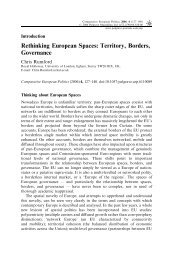Europeanisation, National Identities and Migration ... - europeanization
Europeanisation, National Identities and Migration ... - europeanization
Europeanisation, National Identities and Migration ... - europeanization
You also want an ePaper? Increase the reach of your titles
YUMPU automatically turns print PDFs into web optimized ePapers that Google loves.
110 Krystyna Romaniszyn<br />
(further) diversification. The analysis does not pretend to completeness as there are<br />
very probably other dimensions of cultural diversification brought about by<br />
the inflows that have not been addressed here <strong>and</strong> are to be searched for. It rather<br />
promotes the novel subject in the research on migration, <strong>and</strong> on cultural change<br />
ongoing in the European nation-states, <strong>and</strong> thus supplements the analysis of the<br />
<strong>Europeanisation</strong> process set in motion by European integration.<br />
Cultural pluralism – dilemmas with governance<br />
Cultural diversification brought about by international migration reveals itself in<br />
the above-mentioned pluralisation of all spheres of the affected culture, <strong>and</strong> the<br />
differentiation of the recipient state’s ethnic structure. The latter instance poses<br />
the problem of the management of ethnic pluralism that has become a constant<br />
characteristic of the European receiving nation-states. It shapes the new Europe<br />
along with the progressive consolidation <strong>and</strong> unification of the European nationstates,<br />
stemming from the European Union enlargement process, further intensified<br />
by the collapse of the Soviet bloc. Thus, the twofold inner cultural diversification<br />
of the European nation-states, resulting from the admission of the newcomers, forms<br />
a context for the opposite process: the <strong>Europeanisation</strong>.<br />
The permanence of immigrant residence <strong>and</strong> the development of their ethnic<br />
enclaves call for the implementation of the effective measures promoting the<br />
peaceful co-existence of numerous ethnic minorities within a nation-state. A crucial<br />
issue regarding the management of ethnic, <strong>and</strong> subsequent cultural, pluralism within<br />
nation-states is summed up in the following questions: to what extent must a national<br />
culture change in order to integrate minorities? What is the status of minorities’<br />
culture, including religion vis-à-vis the dominant culture? Roughly, the debates<br />
on the management of ethnic <strong>and</strong> cultural pluralism focus either on the interests of<br />
the nation-state <strong>and</strong> its dominant culture, or on civil society as a remedy to ethnicity.<br />
As one party thinks of protecting, by skilled management, the cultural centre (core)<br />
against the alien cultures, the other calculates on dismantling the nation-state.<br />
The ultimate aim of the former strategy is the full integration of immigrants <strong>and</strong><br />
their offspring, who are expected to reconcile their cultural heritage with the dominant<br />
culture. Cultural homogeneity is perceived as the basis for the politically<br />
centralised nation-state. In the latter case, the usually unspoken ideal, matching<br />
the development of a modern liberal creed, seems to be the ‘post-nation’ state. In<br />
both cases, despite the differences between them, ethnic cultures are expected to<br />
adjust to the model of co-existence set by the dominant culture that preserves<br />
dominant status for itself.<br />
A good start to a discussion of this issue is provided by the ideal types of response<br />
to ethnic diversity, set out by Modood (1997: 21ff.). The first two, ‘the decentred<br />
self’ <strong>and</strong> the ‘liberal state’ solutions offer politically constituted multiculturalism<br />
where individuals relate to the state as citizens, not as members of any groups, ethnic<br />
ones included. Such a state is ‘group-blind, it cannot “see” colour, gender, ethnicity,<br />
religion or even nationality’ which remain private to individuals (ibid.: 22). The<br />
‘republic’ remedy also does not recognise groups <strong>and</strong> relates to each citizen as an



